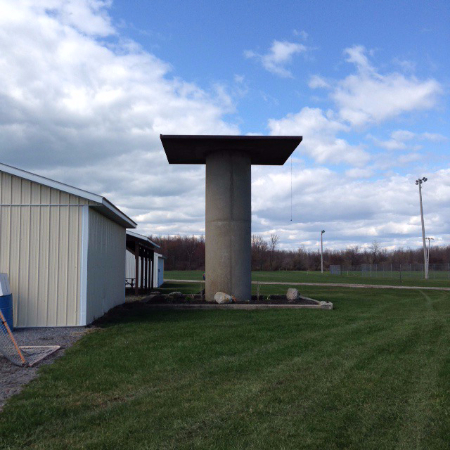Hamburg NIKE Missile Base

Out of this mission arose the Nike missile system, which in 1953 became the first operational anti-aircraft missile system. Between 1953 and 1962, the United States Army developed nearly 250 Nike missile bases in the United States. One of those was the Hamburg Nike Missile Base, which became operational in June of 1956.
The Hamburg base, designated BU-52, as well as the Nike missile bases in Orchard Park, Lancaster and Millersport were located so as to create a defensive zone that would protect the Buffalo population as well as the local steel and iron mills. There was an additional defensive zone for Niagara Falls with Nike missile bases in Sanborn, Grand Island and Model City in Lewiston. These sites were located so as to protect the Niagara Falls area and its power generating facilities. The two defensive zones were merged in December 1961.
Generally, the Nike missile bases consisted of two separate sites, one being the Integrated Fire Control (IFC)/administration site and the other being the magazine/launch site. For BU-52, the IFC site was located at 2982 Lakeview Road at the Town of Hamburg Recreation Center. The magazine/launch site was located further down the road at 2720 Lakeview Road at the Town Highway Department facility.
BU-52 was referred to as a double site, meaning it could engage 2 targets simultaneously. Located at the IFC site were 3 types of radars, one being the Acquisition Radar (ACQR), another being the Target Tracking Radar (TTR) and the third being the Missile Tracking Radar (MTR). The ACQR would detect an aircraft. Once the aircraft was determined to be hostile, the TTR would lock onto the aircraft, while the MTR locked onto the missile. Both the TTR and MTR were linked to a guidance computer. At the moment of closest approach, the computer would detonate the missiles warhead.
As a double site, the magazine/launch site contained a total of 60 supersonic Nike Ajax supersonic missiles which were stored horizontally in 6 underground magazines. Above ground there were 24 launchers (4 per magazine). The missiles were brought to the surface by means of an elevator and then attached, via a system of rails, to a launcher. Two launchers would be on 15 minutes alert, two on thirty minutes alert and two on one or two hour alert. The missiles could reach a speed of 1,600 mph.
With the advent of more powerful missiles, including Intercontinental Ballistic Missiles, the Nike bases began to be phased out. BU-52 was closed in December 1961 and by 1974 nearly all Nike bases were closed. Today, one can still see 4 of the remaining radar towers at the Hamburg IFC site. Recently, the magazine/launch site was demolished. Up until then, one could still see the six steel doors through which passed the missiles as they came up from each magazine to the surface. The magazine stairway entrance doors and the magazine air exhaust shafts were also visible.
Volunteer
Looking to help out? We are always in need of volunteers to assist in our goal.
Become a Member
Interested in becoming a member of the Society? We would love to have you and it is easy to join.